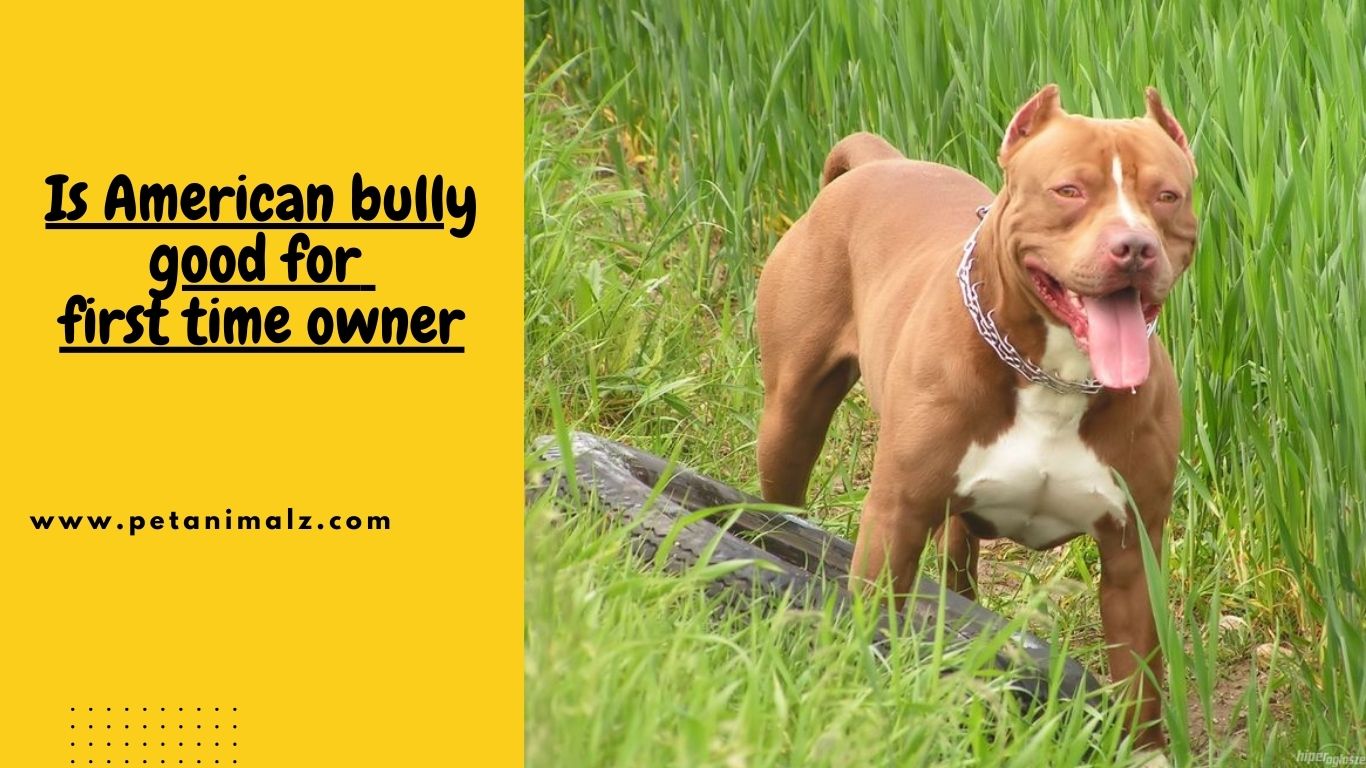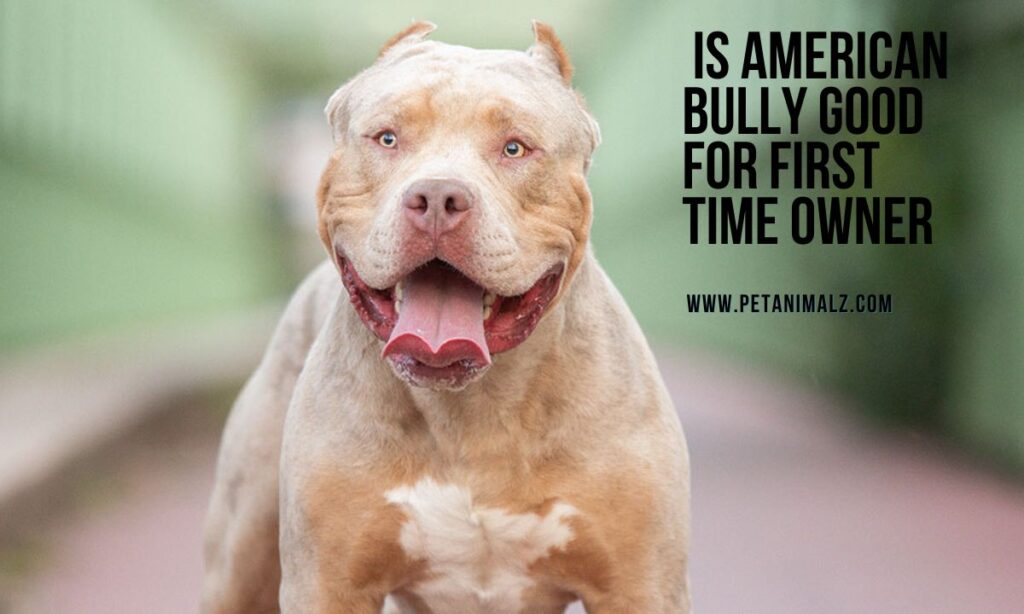Is American bully good for first time owner: Complete Guide
Introduction
In this article complete information about Is American Bully good for first time owner is given. The American Bully is a breed that often captures attention, both for its unique appearance and the cloud of myths surrounding it.
Many first-time dog owners find themselves drawn to this breed, but is it the right choice for them? Before diving into the world of dog ownership, it’s crucial to understand the breed you’re considering. Let’s delve into the history, characteristics, and common misconceptions about the American Bully.

Is American bully good for first time owner: Complete Guide
1. Background of the American Bully
- Origin and History: The American Bully originated in the 1980s, bred primarily from the American Pit Bull Terrier and the American Staffordshire Terrier. It was developed to be a family companion dog with a gentler temperament.
- Difference between American Bully and Other Bully Breeds: While they might share a similar name, the American Bully is distinct from other bully breeds. Its physical characteristics and temperament set it apart from its more aggressive ancestors.
- Popularity Growth Over the Years: Over the past few decades, the American Bully has seen a surge in popularity. Its loyal nature and striking appearance have made it a favorite among many dog enthusiasts.
The American Bully Is a Gentle and Affectionate Breed
Absolutely, the American Bully is often described as being gentle, affectionate, and a great family companion. Despite their muscular appearance and strong build, they are known for their friendly demeanor, especially when properly trained and socialized from a young age. Here’s a closer look at the temperament and characteristics of the American Bully:

- Loyal and Loving: American Bullies are known for their loyalty to their families. They form strong bonds with their owners and often thrive on human interaction.
- Great with Children: When introduced to children in a positive manner, American Bullies can be gentle and patient, making them excellent family pets. Their affectionate nature often shines through when they are around kids.
- Friendly with Strangers: While they can be wary of strangers, especially if they sense a threat to their family, they are generally friendly once they assess that there’s no danger.
- Social with Other Animals: With proper socialization, many American Bullies get along well with other dogs and pets. However, like all breeds, early and positive introductions are crucial.
- Eager to Please: This breed is known to be eager to please its owners, which can make training more straightforward. They respond well to positive reinforcement techniques.
- Confident and Assertive: While they are gentle and affectionate, American Bullies are also confident and can be assertive. This assertiveness, however, should not be mistaken for aggression.
- Low Aggression: Contrary to some misconceptions, the American Bully is not an inherently aggressive breed. Issues of aggression, when they do occur, are often the result of poor training, neglect, or abuse.
- Adaptable: American Bullies can adapt to various living situations, whether it’s a house with a yard or an apartment, as long as they receive adequate exercise and attention.
It’s essential to remember that, like all dog breeds, individual temperament can vary. Proper training, socialization, and a loving environment play significant roles in shaping a dog’s behavior. The American Bully, when raised in a positive setting, can be a loving and gentle companion, debunking many of the myths surrounding its temperament.
American Bullies Are Quite Low Maintenance
The American Bully is often considered a low-maintenance breed in terms of grooming and general care, especially when compared to some other breeds. Here’s a breakdown of the maintenance aspects of the American Bully:
- Grooming:
- Coat: The American Bully has a short, smooth coat that doesn’t require frequent grooming. A weekly brush will help remove loose hairs and keep the coat looking its best.
- Bathing: They don’t need frequent baths unless they get into something messy. Bathing once a month or even less frequently is usually sufficient.
- Nails: Like all dogs, their nails should be trimmed regularly, especially if they don’t wear down naturally.
- Ears and Teeth: Regular checks and cleaning of the ears and teeth are essential to prevent infections and dental issues.
- Exercise:
- While they are energetic and enjoy playtime, they don’t require extensive daily exercise. Regular walks and some playtime in the yard or park are usually sufficient for this breed.
- Health:
- American Bullies are generally healthy, but like all breeds, they can be prone to certain health issues. Regular veterinary check-ups and a balanced diet will help ensure they stay healthy.
- It’s essential to be aware of potential genetic health issues, like hip dysplasia, and choose breeders who prioritize health screenings.
- Training:
- While they are eager to please and generally responsive to training, early socialization and positive reinforcement techniques are crucial. This ensures they grow up to be well-behaved and sociable adults.
- They can be stubborn at times, so consistency in training is essential.
- Space:
- American Bullies are adaptable to various living situations. They can live comfortably in apartments as long as they get regular walks and playtime.
- Temperament:
- Their balanced and friendly temperament means they don’t require extensive behavioral training as long as they are socialized and trained from a young age.
- Diet:
- They aren’t particularly fussy eaters. A balanced diet, whether commercial or home-cooked (with veterinary guidance), will suffice.
While the American Bully is relatively low-maintenance, especially in terms of grooming, it’s essential to provide them with regular veterinary care, a balanced diet, and consistent training to ensure they lead a healthy and happy life.
Professional Breeders Train and Socialize Them Before Rehoming Them
Reputable and professional breeders prioritize the early training and socialization of puppies before rehoming them. This practice ensures that the puppies have a solid foundation, making the transition to their new homes smoother and setting them up for success in their new environments. Here’s what this early training and socialization typically involve:
- Early Socialization:
- Puppies are exposed to various sounds, sights, and experiences in a controlled manner. This can include the sounds of household appliances, exposure to different types of flooring, interaction with various people, and more.
- They might be introduced to other animals, including other dogs, to ensure they are comfortable around them.
- Basic Training:
- Puppies often learn fundamental commands like “sit,” “stay,” and “come.”
- They are introduced to crate training, which not only provides a safe space for the puppy but also aids in housebreaking.
- Bite inhibition is taught, ensuring that the puppy learns to control the force of its bite during play.
- Handling:
- Puppies are accustomed to being handled, which includes checking their ears, paws, and mouth. This makes future grooming and veterinary visits easier.
- Housebreaking:
- Many breeders start the process of housebreaking, teaching puppies to do their business in designated areas.
- Feeding Routine:
- Puppies are often put on a regular feeding schedule, which aids in digestion and housebreaking.
- Behavioral Monitoring:
- Reputable breeders observe puppies for any signs of behavioral issues. This allows them to address any problems early on and provide guidance to new owners.
- Health Care:
- Puppies receive their initial vaccinations and health checks. Breeders ensure that puppies are in good health before rehoming.
- Guidance for New Owners:
- Professional breeders provide new owners with guidance on continuing training, socialization, diet, and health care. They often remain a resource for owners, answering questions and providing support as the puppy grows.
It’s essential for potential dog owners to choose reputable breeders who prioritize the well-being and development of their puppies. Early training and socialization play a crucial role in a dog’s behavior and temperament as it matures. When breeders invest time and effort into these early stages, it benefits the puppy, the new owners, and the breed as a whole.
2. Characteristics of the American Bully
- Physical Appearance: The American Bully boasts a muscular and compact frame. They have a broad head, short coat, and can vary in size from pocket to XL.
- Temperament and Behavior: Contrary to popular belief, the American Bully is known for its friendly and affectionate nature. They are great with families, showing a particular fondness for children. Their loyalty and protective nature make them excellent companions.
- Common Misconceptions Debunked:
- Aggressiveness: Many assume the American Bully to be aggressive due to its lineage. However, with proper training and socialization, they are among the most loving breeds.
- High Maintenance: While they do require regular exercise, their grooming needs are minimal, making them relatively low maintenance.
- Health Issues: Like all breeds, they have their health concerns. However, with regular check-ups and a balanced diet, many of these can be mitigated.
In this article, we’ve just scratched the surface of the American Bully breed. As with any dog, understanding and preparation are key. If you’re a first-time dog owner considering an American Bully, you’re in for a treat – but ensure you’re fully equipped to provide the best home for your new furry friend.
Delving Deeper into the Suitability for First-Time Owners
3. Training and Socialization Needs
- Importance of Early Socialization: Early socialization is paramount for American Bullies. Introducing them to various environments, people, and other animals during their puppy phase helps in developing a well-rounded and confident adult dog.
- Training Techniques That Work Best: Positive reinforcement methods, such as treats and praises, work wonders. Consistency and patience are key. Avoid harsh techniques as they can backfire.
- Challenges for First-Time Owners: The breed’s strong-willed nature can be a challenge. It’s essential to establish leadership early on without being overly dominant.
4. Health and Maintenance
- Common Health Issues: American Bullies can face issues like hip dysplasia, allergies, and heart problems. Regular vet check-ups can help in early detection.
- Grooming Needs: Their short coat requires minimal grooming. A weekly brush and occasional baths will suffice.
- Exercise Requirements: They need regular exercise to keep them fit and mentally stimulated. Daily walks and play sessions are recommended.
5. Living Conditions
- Ideal Home Environment: A home with a yard is ideal, but they can adapt to apartment living if they get enough exercise.
- Compatibility with Other Pets and Children: Generally, they are good with children and can coexist with other pets if properly introduced and socialized.
6. Cost Implications
- Initial Costs:
- Adoption/Purchase: Prices can vary based on lineage and breeder reputation.
- Initial Vet Visits: Necessary vaccinations and health checks.
- Ongoing Costs:
- Food: Quality dog food for their size and activity level.
- Grooming: Minimal costs due to their short coat.
- Health Check-ups: Regular vet visits and any medications or treatments.
7. FAQs
Are American Bullies aggressive?
No, they are generally affectionate and friendly. However, like any breed, individual temperament can vary.
How long do American Bullies live?
On average, they live between 8-12 years.
What is the difference between an American Bully and a Pitbull?
While they share some ancestry, American Bullies are bred primarily for companionship, leading to differences in appearance and temperament.
Are American Bullies high maintenance?
Not particularly. They require regular exercise and basic grooming, but their needs are manageable.
Are American Bully good for beginners?
Yes, American Bullies can be suitable for beginners, especially if they’re committed to proper training and socialization. Their affectionate nature makes them a joy to have around, but like any breed, they require consistent training.
Is American Bully good for home?
Absolutely. American Bullies are known for their loyalty and can be great family dogs. They adapt well to home environments, whether it’s an apartment or a house with a yard.
Is American Bully hard to maintain?
Not particularly. Their short coat requires minimal grooming. However, they do need regular exercise to keep them mentally and physically stimulated.
Are American Bullies good with strangers?
With proper socialization, American Bullies can be friendly and sociable with strangers. However, their protective nature might make them wary of unfamiliar people initially.
Is American Bully better than Pitbull?
It’s not about one being “better” than the other; it’s about which is more suitable for a particular individual or family. Both breeds have their unique characteristics and temperaments. American Bullies are generally more relaxed and bred for companionship, while Pitbulls are more energetic.
How do I choose a Bully puppy?
Look for reputable breeders who prioritize health and temperament. Observe the puppy’s behavior, check for signs of good health, and ask the breeder about the puppy’s lineage and any health guarantees.
Are American Bully shy?
Not typically. However, like all dogs, individual temperaments can vary. Proper socialization from a young age can prevent shyness and fearfulness.
Are Bully dogs loyal?
Yes, American Bullies are known for their loyalty and strong bond with their families.
Why American Bullies are the best?
Many owners believe American Bullies are the best because of their affectionate nature, loyalty, and adaptability. They’re great family dogs and are known to be especially good with children.
Which bully dog is best?
This depends on what you’re looking for in a dog. There are various bully breeds, including the American Bully, Pitbull, Staffordshire Bull Terrier, and more. Each has its unique characteristics, so it’s essential to research and find the one that fits your lifestyle.
What is the best age to breed a bully?
It’s generally recommended to wait until the American Bully is at least 2 years old and has undergone necessary health screenings before considering breeding.
What is the easiest bully breed to own?
The “easiest” breed varies based on individual preferences and lifestyles. However, many find the American Bully to be one of the more manageable bully breeds due to its relaxed temperament and minimal grooming needs.
8. Conclusion
Choosing an American Bully as your furry companion comes with its set of challenges and rewards. Their loyal and affectionate nature can make them a joy to have around. However, like adopting any pet, it’s essential to weigh the pros and cons. Remember the time my Bully, Max, decided to play in the mud after his bath? It was a mess, but his guilty face was worth it! If you’re considering this breed, dive deep into research, and prepare for a journey filled with love, laughter, and a few learning curves.




